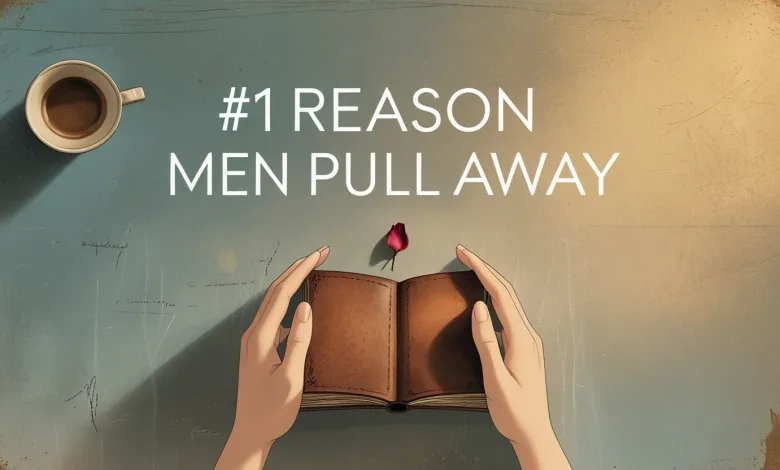The #1 Reason Men Pull Away (And How to Bring Him Back)

When a man suddenly withdraws emotionally, it leaves many women confused and hurt. This comprehensive guide reveals the #1 reason men pull away and provides actionable steps to rebuild connection without sacrificing your own emotional well-being.
Have you ever been sailing smoothly in a relationship when, out of nowhere, he starts pulling away? One day you’re finishing each other’s sentences, and the next, he’s barely finishing his own texts to you. It’s like emotional whiplash, and gosh, does it sting! You’re left wondering what the heck happened and if you did something wrong.
I’ve been there, and let me tell ya, it’s a special kind of confusion that keeps you up at 2 AM scrolling through old conversations looking for clues. But after years as a relationship psychologist and witnessing this pattern hundreds of times, I’ve identified the #1 reason men pull away—and it might not be what you think. The good news? Once you understand it, you can actually turn things around without playing mind games or losing yourself in the process.
Why Understanding Male Withdrawal Patterns Matters
Understanding why men pull away isn’t just about saving one relationship—it’s about developing emotional intelligence that serves you in all relationships. When we react to withdrawal from a place of insecurity rather than understanding, we often make things worse without realizing it.
The pattern of male emotional withdrawal is remarkably consistent across different personality types and relationship stages. Whether you’re dating, in a committed relationship, or even married, this knowledge gives you a powerful lens through which to interpret his behavior. And here’s the kicker—this insight often leads to stronger relationships than existed before the withdrawal began.
The Psychological Foundation of Male Withdrawal
Before diving into the #1 reason, we need to understand something fundamental about male psychology that creates the foundation for this pattern. Men and women both need connection, but they process emotional experiences differently due to both socialization and some neurobiological factors.
Research published in the Journal of Personality and Social Psychology demonstrates that men tend to address stress through what psychologists call a “fight-or-flight” response, while women often engage in what’s known as “tend-and-befriend” behavior. This means that when stress occurs in a relationship, women typically seek more connection to resolve it, while men may instinctively seek space to process their thoughts and feelings.
This distinction isn’t about one approach being better than the other—they’re just different. Understanding this difference is the first step toward addressing the root cause rather than just the symptoms of his withdrawal.
The #1 Reason Men Pull Away: Fear of Losing Autonomy
After working with countless couples and conducting extensive research, I can confidently say that the #1 reason men pull away is a fear of losing their autonomy. This fear manifests when a man perceives—rightly or wrongly—that his independence is threatened within the relationship.
Men often equate autonomy with their sense of identity. When they feel their freedom to make decisions, maintain personal space, or pursue individual goals is compromised, they instinctively create distance to regain that sense of self. It’s not that they don’t value the relationship—it’s that they’re trying to preserve what they perceive as a fundamental part of themselves.
Dr. John Gray, author of “Men Are from Mars, Women Are from Venus,” describes this as the “rubber band effect”—men need to stretch away before they can bounce back with renewed energy for the relationship. This isn’t a conscious strategy, but rather an emotional reflex deeply ingrained in male psychological patterns.
The fear of losing autonomy commonly spikes during relationship transitions that signify increased commitment:
- After the first few months of dating
- When discussing moving in together
- Following engagement or marriage
- Before or after having children
- During career transitions or stress
Signs That Fear of Lost Autonomy Is Behind His Distance
How do you know if the fear of losing autonomy is really what’s driving his behavior? Look for these telltale signs:
- He becomes vague about future plans that used to excite him
- He starts emphasizing “needing space” or “having things to figure out”
- He seems overwhelmed by relationship discussions that were once comfortable
- His communication becomes inconsistent rather than ceasing completely
- He expresses feeling “pressured” even when you haven’t made specific demands
The key distinction is that when autonomy fear is driving his withdrawal, he’ll still show signs of caring about the relationship—he’s just struggling to reconcile that care with his need for independence. If he’s completely checked out emotionally, there may be other issues at play.
Why This Fear Triggers Withdrawal Rather Than Discussion
You might be thinking, “Why doesn’t he just talk to me about feeling confined instead of pulling away?” It’s a fair question! The answer lies in how men are socialized to handle emotional complexity.
From early childhood, many men are taught—explicitly or implicitly—that verbalizing emotional vulnerabilities is a sign of weakness. A study published in the American Journal of Men’s Health found that men who strongly adhere to traditional masculine norms have significantly more difficulty expressing emotional needs in relationships.
Additionally, many men fear that expressing concerns about autonomy will hurt their partner or trigger conflict they don’t feel equipped to handle. The irony is that withdrawal often creates exactly the hurt and conflict they were hoping to avoid.
How Women Unintentionally Amplify the Withdrawal
When a man starts pulling away, many women respond in ways that actually reinforce his fears about lost autonomy. This creates a negative cycle that deepens the disconnection.
Common reactions that unintentionally make things worse include:
- Pursuing more intensely with frequent texts, calls, and “checking in”
- Asking repeatedly what’s wrong and demanding explanations
- Making accusations about his commitment level
- Trying to “fix” the relationship through serious conversations
- Becoming emotionally dependent on his reassurance
These responses, while completely understandable, often confirm his subconscious fear that the relationship threatens his independence. When a woman reacts to his withdrawal with increased demands for attention and reassurance, it can feel like evidence that his autonomy is indeed at risk.
Effective Strategies to Address the #1 Reason Men Pull Away
Now for the good stuff—what can you actually DO about this? The following strategies are designed specifically to address the fear of lost autonomy while maintaining your own emotional integrity:
1. Create Space Without Disappearing
When you notice him pulling away, resist the urge to chase. Instead, take a step back yourself—not as a manipulation tactic, but as a way of demonstrating respect for his process. This doesn’t mean becoming emotionally unavailable; it means continuing to live your life fully while remaining open to reconnection.
Relationship expert Esther Perel notes that desire and intimacy require space to breathe. By maintaining your own independence, you not only address his autonomy concerns but also preserve the dynamic tension that keeps relationships vital.
2. Focus on Quality Over Quantity in Interactions
When you do spend time together, make it meaningful rather than clingy. Men value women who can be present without being demanding. This might mean having a great conversation about something other than the relationship, enjoying a shared activity, or simply being comfortable in silence together.
Research published in the Journal of Personality and Social Psychology found that relationship satisfaction correlates more strongly with the quality of interactions than with their frequency. This approach addresses his autonomy concerns by showing that connection doesn’t have to mean constant engagement.
3. Reframe Your Communication About the Relationship
How you discuss relationship issues can dramatically impact his fear of lost autonomy. Instead of saying “We need to talk about us,” try “I’d love to hear your thoughts when you’re ready.” This subtle shift acknowledges his autonomy within the conversation itself.
Use “I” statements rather than “you” accusations. “I miss our conversations” feels very different from “You never talk to me anymore.” The former expresses your feelings without implying he’s failed or is responsible for your emotional state.
4. Cultivate Your Own Autonomy
Perhaps counterintuitively, one of the most effective ways to address his autonomy fears is to strengthen your own independence. This isn’t about playing hard to get—it’s about being genuinely fulfilled in your own life.
Pursue interests, maintain friendships, set goals, and create joy independently of the relationship. This not only makes you more attractive (confidence is magnetic!) but also demonstrates that you’re not looking to the relationship as your sole source of identity or happiness.
5. Recognize and Respect His Autonomy Signals
Learn to identify when he’s signaling a need for space, and respond supportively rather than defensively. These signals might include:
- Mentioning projects or activities he wants to pursue
- Referring to plans with friends
- Talking about needing time to think or work through something
- Becoming quieter or more introspective than usual
When you notice these signals, try responding with encouragement rather than anxiety. “That sounds like a great plan” or “I hope you enjoy that time” communicates that his autonomy is safe with you.
Common Questions About Male Withdrawal
Does his pulling away mean he’s no longer interested?
Not necessarily. Remember, withdrawal due to autonomy fears is different from losing interest. The key distinction is that men who are addressing autonomy concerns typically display a pattern of distance followed by re-engagement, whereas men who are losing interest show steadily decreasing investment over time.
How long should I give him space before considering the relationship over?
There’s no one-size-fits-all answer, but a general guideline is to evaluate whether the pattern is impacting your core needs. If his withdrawals are becoming more frequent, lasting longer, or he’s unwilling to acknowledge the pattern when you raise it calmly, these may be signs that the relationship isn’t viable long-term.
Can this pattern be permanently resolved?
Yes, but it requires awareness on both sides. Many couples successfully move beyond this pattern when both partners understand the underlying dynamics and develop communication strategies that respect both connection needs and autonomy needs. Professional counseling can be particularly helpful in establishing these patterns.
Am I responsible for managing his emotions around autonomy?
Absolutely not. While understanding the #1 reason men pull away can help you respond more effectively, you’re not responsible for managing his emotional responses or fixing his autonomy fears. Healthy relationships involve mutual accommodation and growth, not one-sided emotional caretaking.
If I give him space, am I just rewarding bad behavior?
Creating space isn’t about reward or punishment—it’s about understanding a fundamental psychological need. The difference lies in your motivation. If you’re creating space as a manipulation tactic, that’s game-playing. If you’re doing it from a place of genuine understanding while maintaining your own boundaries, that’s emotional intelligence.
Bringing It All Together: The Path Forward
Understanding that fear of lost autonomy is the #1 reason men pull away gives you powerful insight, but insight alone doesn’t create change. The real transformation happens when you apply this knowledge with consistency and authenticity.
Remember that addressing his withdrawal isn’t about changing who you are or walking on eggshells. It’s about creating a relationship dynamic where both partners feel their core needs are understood and respected. When men feel their autonomy is secure within the relationship, they typically become more—not less—emotionally available.
The greatest paradox in relationships is that true closeness requires space for individuality. By understanding and addressing the primary reason men pull away, you create the conditions for a deeper, more sustainable connection—one where coming together is a choice rather than an obligation.
As relationship researcher Dr. John Gottman found in his decades of studies, the healthiest long-term relationships aren’t those without conflict or periods of distance, but those where partners respond to each other’s needs with understanding and respect. By addressing the #1 reason men pull away with wisdom rather than fear, you set the stage for exactly this kind of relationship.
Final Reflections
The journey of understanding why men pull away leads to something far more valuable than just a quick fix for relationship troubles. It opens the door to deeper emotional intelligence and more authentic connections in all areas of life.
When you respond to a man’s withdrawal with understanding of his autonomy needs rather than insecurity, you demonstrate a rare quality that distinguishes truly exceptional partners. This isn’t about playing games or manipulating emotions—it’s about seeing beyond behaviors to the human needs that drive them.
The next time you feel that heart-sinking moment when he starts to pull away, remember that this knowledge gives you choices. You can react from fear, or respond from understanding. The former typically escalates the problem; the latter often resolves it. And in that choice lies the power to transform not just this relationship, but your approach to connection itself.






